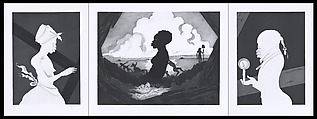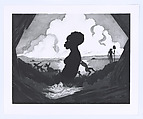Resurrection Story with Patrons
Kara Walker American
Printer Gregory Burnet
Not on view
Walker employs the aesthetic of the cut-paper silhouette—a technique developed in the eighteenth century and used largely for portraiture—to challenge narratives of race and sexuality borne out of antebellum stereotypes and prejudices. She juxtaposes the silhouette’s formal beauty with horrific scenes of brutality, connecting the violence of slavery with the arts and culture that both normalized and profited from it. Here, Walker engages with depictions of Christian martyrdom, a dominant motif in much of the art she encountered during a residency in Rome, as well as with contemporary reports of racial violence and the creation of the Black Lives Matter movement. The triptych form references the altarpiece tradition; the central section shows small figures elevating a monumental sculpture of a naked black woman, while the side panels contain male and female figures in reverse silhouette who allude to the patrons represented in a typical altarpiece commission.
Due to rights restrictions, this image cannot be enlarged, viewed at full screen, or downloaded.
This artwork is meant to be viewed from right to left. Scroll left to view more.








